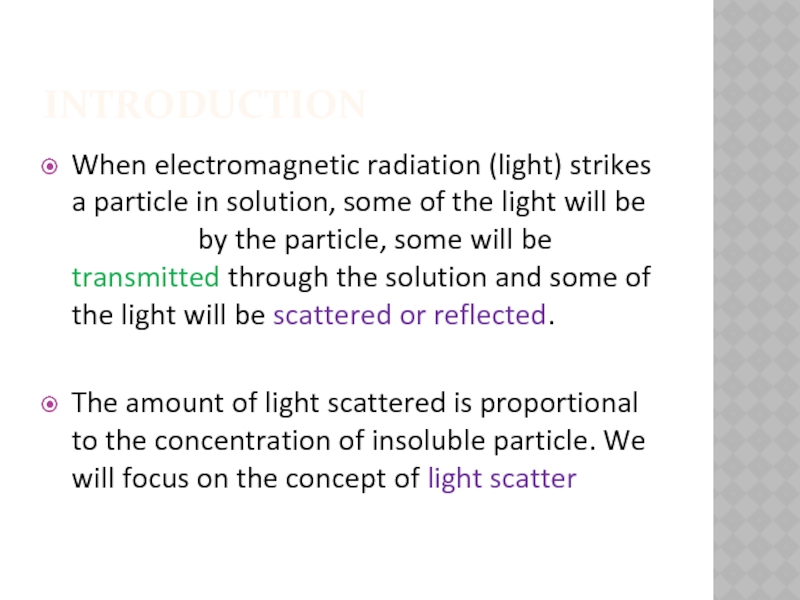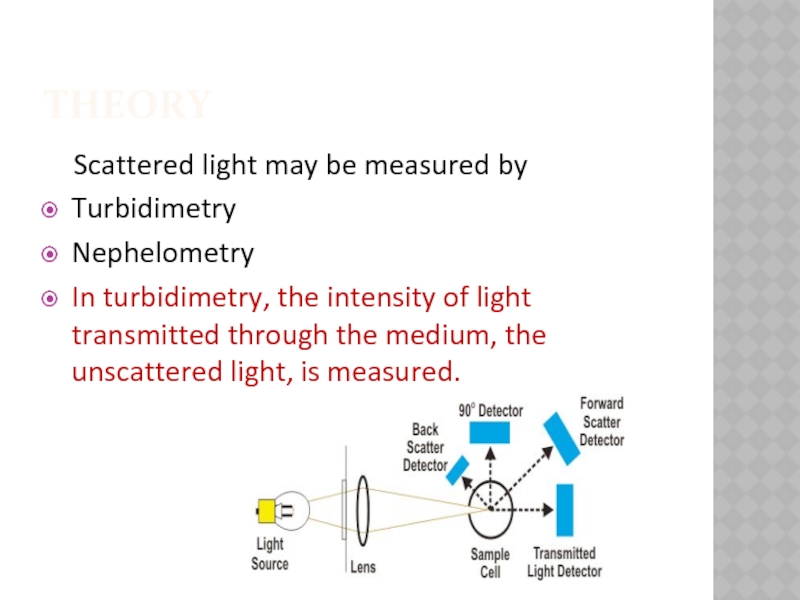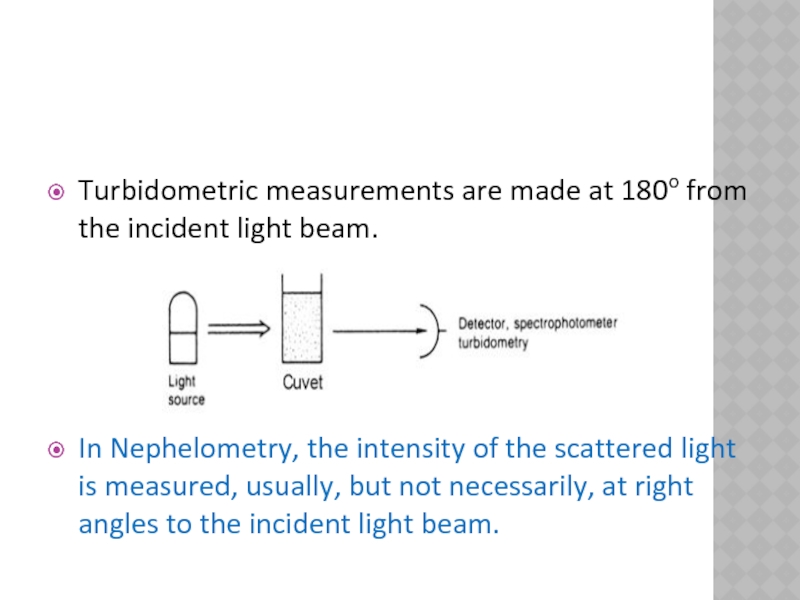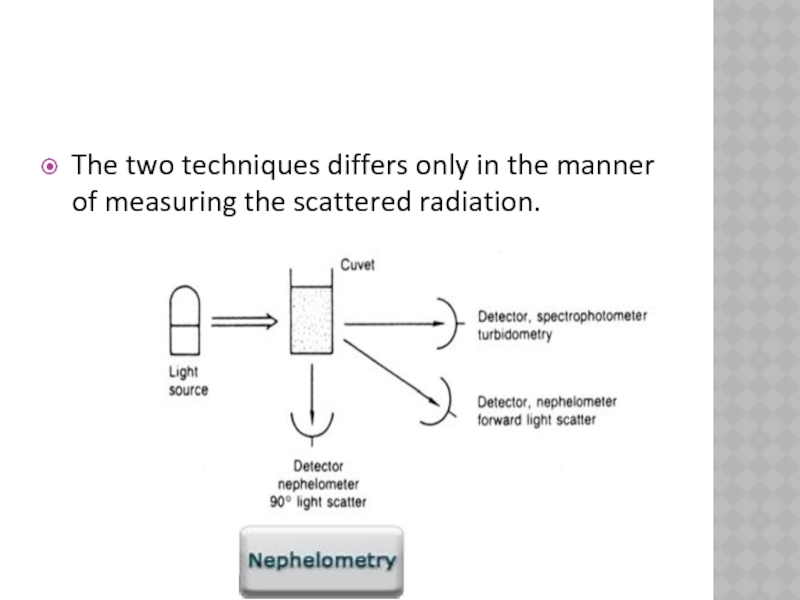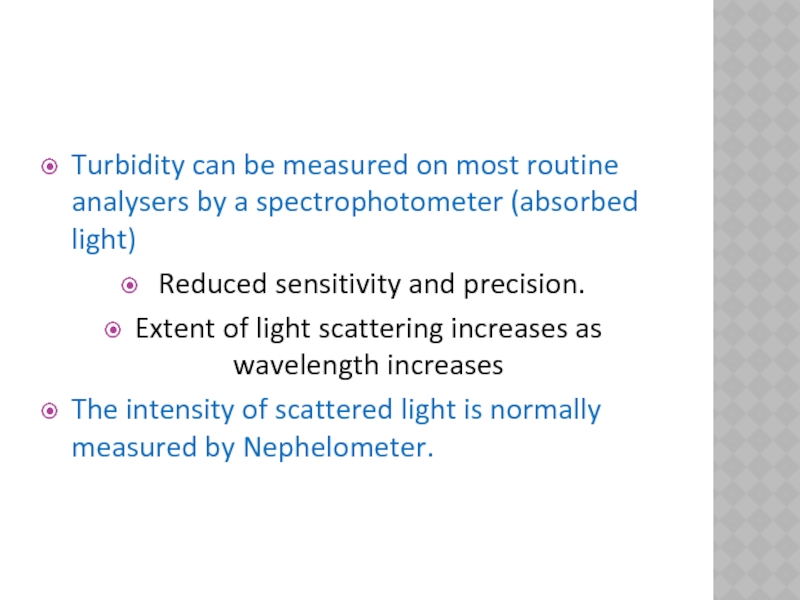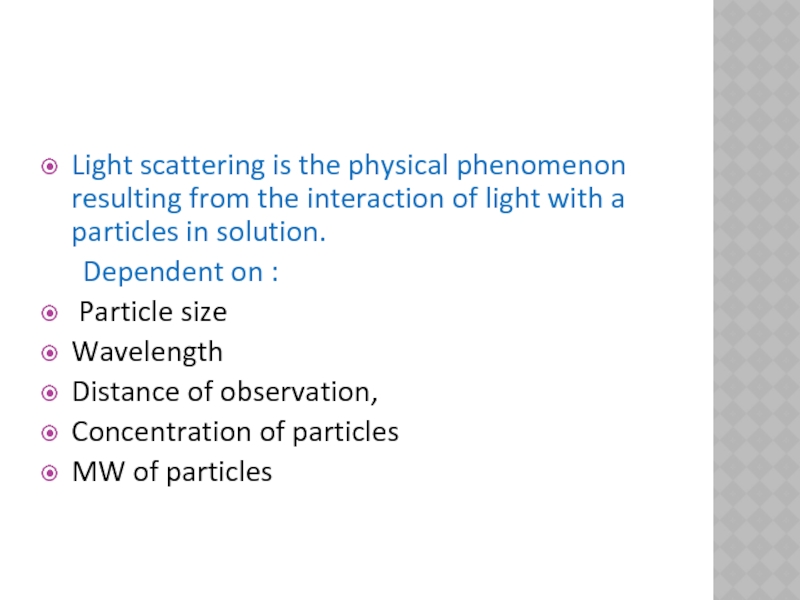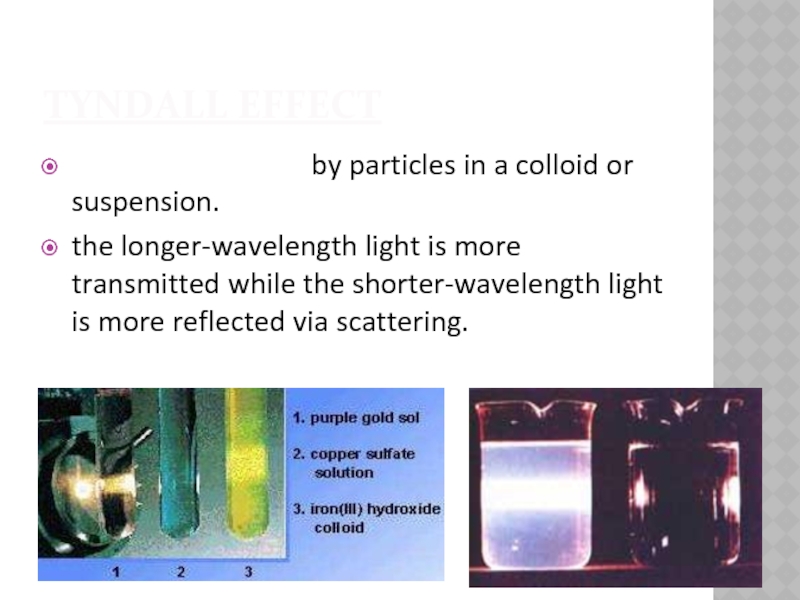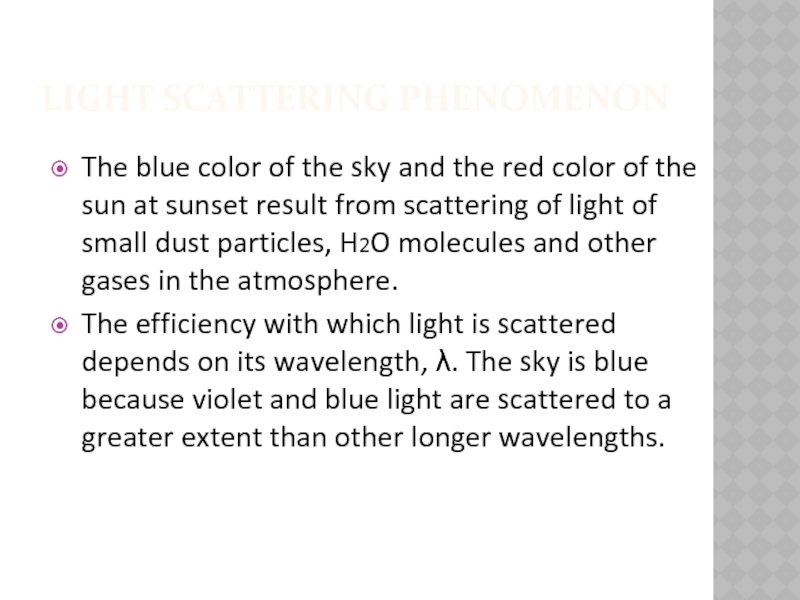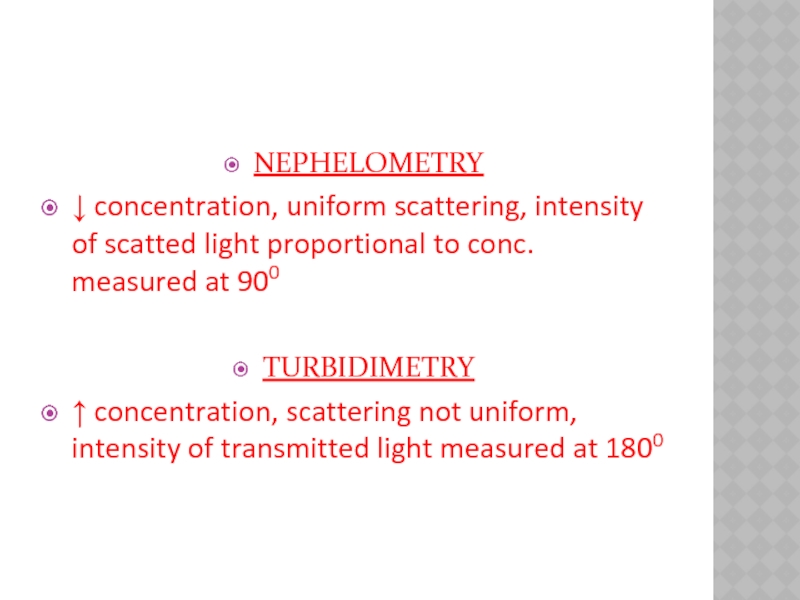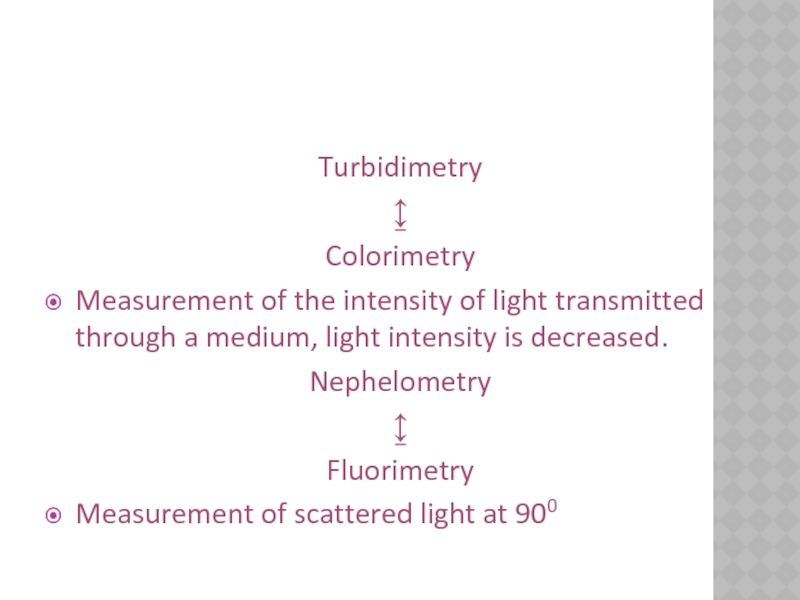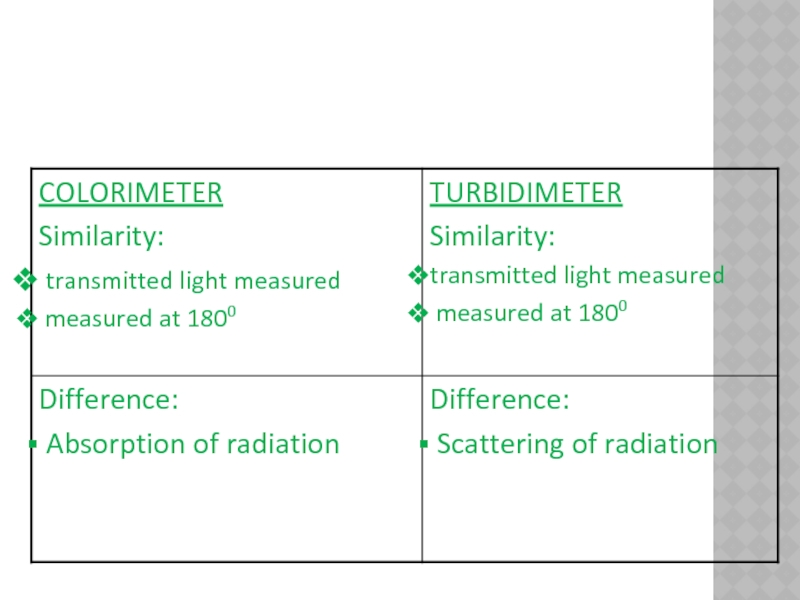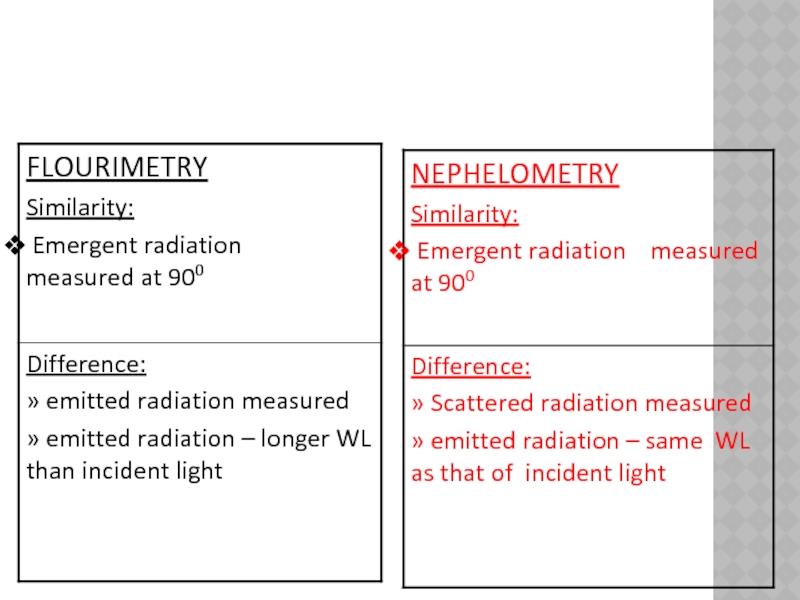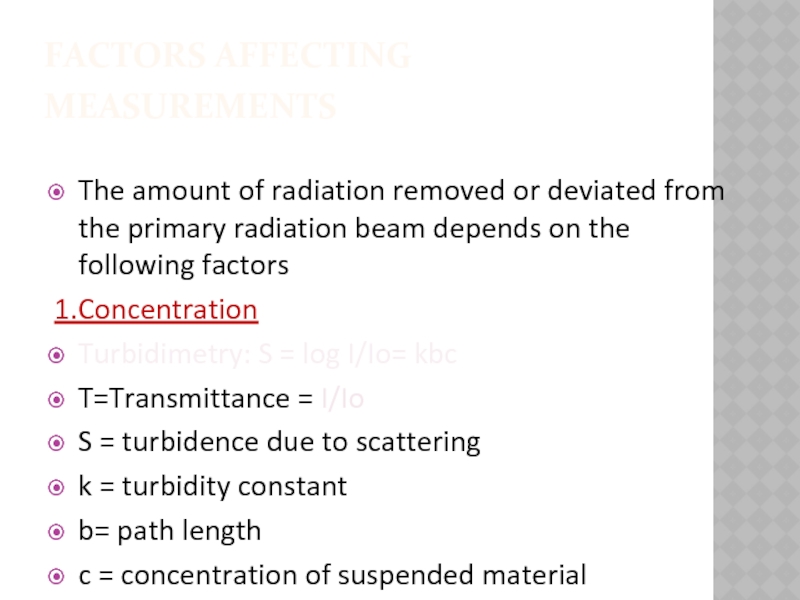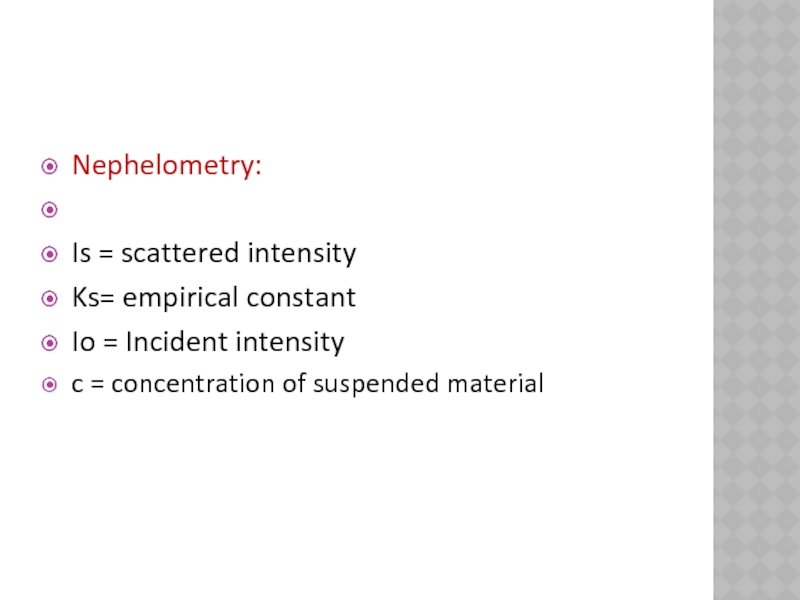- Главная
- Разное
- Дизайн
- Бизнес и предпринимательство
- Аналитика
- Образование
- Развлечения
- Красота и здоровье
- Финансы
- Государство
- Путешествия
- Спорт
- Недвижимость
- Армия
- Графика
- Культурология
- Еда и кулинария
- Лингвистика
- Английский язык
- Астрономия
- Алгебра
- Биология
- География
- Детские презентации
- Информатика
- История
- Литература
- Маркетинг
- Математика
- Медицина
- Менеджмент
- Музыка
- МХК
- Немецкий язык
- ОБЖ
- Обществознание
- Окружающий мир
- Педагогика
- Русский язык
- Технология
- Физика
- Философия
- Химия
- Шаблоны, картинки для презентаций
- Экология
- Экономика
- Юриспруденция
NEPHELOMETRY AND TURBIDIMETRY презентация
Содержание
- 1. NEPHELOMETRY AND TURBIDIMETRY
- 2. T.B.EKNATH BABU [T.B.E.K.B] STUDENT AT ARULMIGU KALASALINGAM COLLEGE OF PHARMACY
- 3. INTRODUCTION When electromagnetic radiation (light) strikes a
- 4. THEORY Scattered light may be
- 5. Turbidometric measurements are made at 180o
- 6. The two techniques differs only in the manner of measuring the scattered radiation.
- 7. Turbidity can be measured on most
- 8. Light scattering is the physical phenomenon resulting
- 9. TYNDALL EFFECT Scattering of light- by particles
- 10. LIGHT SCATTERING PHENOMENON The blue color
- 11. NEPHELOMETRY ↓ concentration, uniform scattering, intensity
- 12. Turbidimetry ↨ Colorimetry Measurement of the intensity of
- 15. CHOICE OF THE METHOD depends upon the amount
- 16. INSTRUMENTATION The basic instrument contains Light Source:Tungsten
- 17. CELLS cylindrical cells - flat faces to minimize reflections & multiple scatterings
- 18. FACTORS AFFECTING MEASUREMENTS The amount of
- 19. Nephelometry: Is = Ks Io C
- 20. 2. Effect of Particle Size on
- 21. Turbidimetry-Practical Considerations Selecting λ: Important. It
- 22. APPLICATIONS Analysis of water
- 23. 6. Miscellaneous Water treatment plants,
Слайд 3INTRODUCTION
When electromagnetic radiation (light) strikes a particle in solution, some of
the light will be absorbed by the particle, some will be transmitted through the solution and some of the light will be scattered or reflected.
The amount of light scattered is proportional to the concentration of insoluble particle. We will focus on the concept of light scatter
The amount of light scattered is proportional to the concentration of insoluble particle. We will focus on the concept of light scatter
Слайд 4THEORY
Scattered light may be measured by
Turbidimetry
Nephelometry
In turbidimetry, the intensity
of light transmitted through the medium, the unscattered light, is measured.
Слайд 5
Turbidometric measurements are made at 180o from the incident light beam.
In
Nephelometry, the intensity of the scattered light is measured, usually, but not necessarily, at right angles to the incident light beam.
Слайд 7
Turbidity can be measured on most routine analysers by a spectrophotometer
(absorbed light)
Reduced sensitivity and precision.
Extent of light scattering increases as wavelength increases
The intensity of scattered light is normally measured by Nephelometer.
Reduced sensitivity and precision.
Extent of light scattering increases as wavelength increases
The intensity of scattered light is normally measured by Nephelometer.
Слайд 8
Light scattering is the physical phenomenon resulting from the interaction of light with
a particles in solution.
Dependent on :
Particle size
Wavelength
Distance of observation,
Concentration of particles
MW of particles
Dependent on :
Particle size
Wavelength
Distance of observation,
Concentration of particles
MW of particles
Слайд 9TYNDALL EFFECT
Scattering of light- by particles in a colloid or suspension.
the
longer-wavelength light is more transmitted while the shorter-wavelength light is more reflected via scattering.
Слайд 10
LIGHT SCATTERING PHENOMENON
The blue color of the sky and the red
color of the sun at sunset result from scattering of light of small dust particles, H2O molecules and other gases in the atmosphere.
The efficiency with which light is scattered depends on its wavelength, λ. The sky is blue because violet and blue light are scattered to a greater extent than other longer wavelengths.
The efficiency with which light is scattered depends on its wavelength, λ. The sky is blue because violet and blue light are scattered to a greater extent than other longer wavelengths.
Слайд 11
NEPHELOMETRY
↓ concentration, uniform scattering, intensity of scatted light proportional to conc.
measured at 900
TURBIDIMETRY
↑ concentration, scattering not uniform, intensity of transmitted light measured at 1800
TURBIDIMETRY
↑ concentration, scattering not uniform, intensity of transmitted light measured at 1800
Слайд 12
Turbidimetry
↨
Colorimetry
Measurement of the intensity of light transmitted through a medium, light intensity is decreased.
Nephelometry
↨
Fluorimetry
Measurement of scattered
light at 900
Слайд 15CHOICE OF THE METHOD
depends upon the amount of light scattered by suspended particles present in
solution.
TURBIDIMETRY - high concentrated suspensions
NEPHELOMETRY - low concentrated suspensions
- more accurate results
TURBIDIMETRY - high concentrated suspensions
NEPHELOMETRY - low concentrated suspensions
- more accurate results
Слайд 16INSTRUMENTATION
The basic instrument contains
Light Source:Tungsten lamp,
White light
- nephelometers
Filters - Turbidimeter (blue filter or 530 nm)
Nephelometer (visible filter)
Sample cells
Detectors (photometric)
Filters - Turbidimeter (blue filter or 530 nm)
Nephelometer (visible filter)
Sample cells
Detectors (photometric)
Слайд 18FACTORS AFFECTING MEASUREMENTS
The amount of radiation removed or deviated from
the primary radiation beam depends on the following factors
1.Concentration
Turbidimetry: S = log I/Io= kbc
T=Transmittance = I/Io
S = turbidence due to scattering
k = turbidity constant
b= path length
c = concentration of suspended material
1.Concentration
Turbidimetry: S = log I/Io= kbc
T=Transmittance = I/Io
S = turbidence due to scattering
k = turbidity constant
b= path length
c = concentration of suspended material
Слайд 19
Nephelometry:
Is = Ks Io C
Is = scattered intensity
Ks= empirical constant
Io = Incident
intensity
c = concentration of suspended material
c = concentration of suspended material
Слайд 20
2. Effect of Particle Size on Scattering
Size and the shape of
the particles responsible for the scattering.
Because most analytical applications involve the generation of a colloidally dispersed phase in a solution, those variables that influence particle size during precipitation also affect both turbidimetric and nephelometric measurements.
Because most analytical applications involve the generation of a colloidally dispersed phase in a solution, those variables that influence particle size during precipitation also affect both turbidimetric and nephelometric measurements.
Слайд 21
Turbidimetry-Practical Considerations
Selecting λ: Important. It is necessary to avoid radiation that
is absorbed by the sample.
Sample Preparation
Scattering is related to:
1.Concentration of the scattering particles
2.Particle size
3.Particle shape
Sample Preparation
Scattering is related to:
1.Concentration of the scattering particles
2.Particle size
3.Particle shape
Слайд 22APPLICATIONS
Analysis of water
clarity, conc. of ions
Determination of CO2
Determination
of inorganic substances
Sulphate – barium chloride
Ammonia – Nesslers reagent
Phosphorus – Strychine molybedate
Biochemical Analysis
5. Quantitative Analysis – (ppm level)
Sulphate – barium chloride
Ammonia – Nesslers reagent
Phosphorus – Strychine molybedate
Biochemical Analysis
5. Quantitative Analysis – (ppm level)
Слайд 236. Miscellaneous
Water treatment plants, sewage work, refineries, paper industry
7.
Atmospheric pollution
smokes & fogs
8. Determination of mole. Wt of high polymers
9. Phase titration
NEPHLOTURBIDIMETER
Two detectors
smokes & fogs
8. Determination of mole. Wt of high polymers
9. Phase titration
NEPHLOTURBIDIMETER
Two detectors
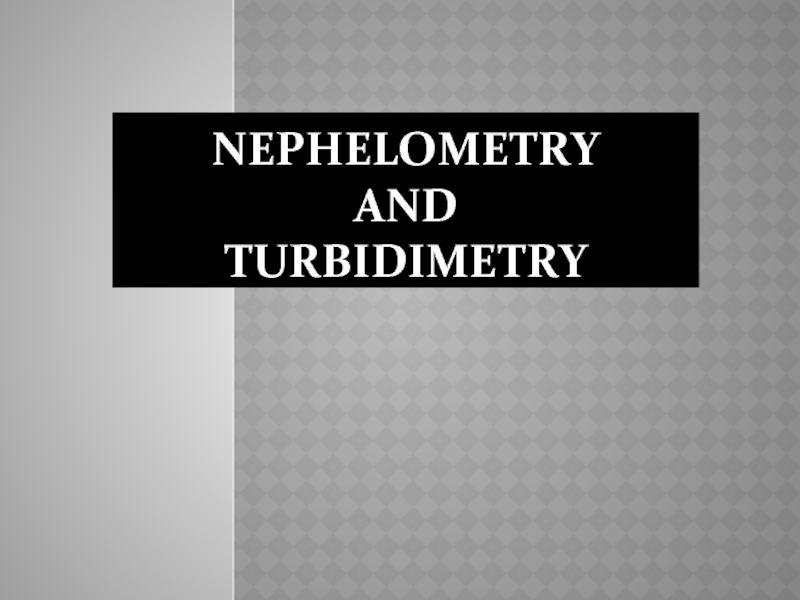
![T.B.EKNATH BABU[T.B.E.K.B]STUDENT AT ARULMIGU KALASALINGAM COLLEGE OF PHARMACY](/img/tmb/2/116591/396e6cf421ebf0632175163c3232d171-800x.jpg)
